Humidity control plays a critical role in maintaining indoor air quality and protecting your property. A dehumidifier is an essential device that reduces excess moisture from the air, improving comfort and preventing a host of humidity-related issues. Whether you live in a tropical climate, suffer from mold problems, or want to improve energy efficiency, a quality dehumidifier can make a significant difference. This comprehensive guide covers everything you need to know about dehumidifiers, including their types, benefits, and how to choose the ideal unit for your needs.
What is a Dehumidifier?
A dehumidifier is an electrical appliance that removes moisture from the air, reducing and maintaining the level of humidity in indoor spaces. Excess humidity can lead to mold growth, musty odors, condensation on windows, and damage to wood or drywall. Dehumidifiers work by drawing in moist air, removing the water content, and then releasing drier air back into the room.
Benefits of Using a Dehumidifier
1. Prevents Mold and Mildew
One of the primary advantages of a dehumidifier is its ability to prevent the growth of mold and mildew, which thrive in damp environments. Mold not only causes structural damage to your property but also poses serious health risks, especially for individuals with allergies, asthma, or compromised immune systems.
2. Improves Indoor Air Quality
By removing excess moisture, dehumidifiers help reduce allergens such as dust mites, mold spores, and bacteria that flourish in humid air. This results in cleaner, healthier air and a more comfortable breathing environment.
3. Protects Property and Furnishings
High humidity can cause wood to warp, paint to peel, and metal to rust. A dehumidifier helps preserve your furniture, electronics, walls, and flooring, protecting your investment and prolonging the life of your home’s interior.
4. Reduces Energy Costs
When indoor air is humid, your air conditioning system has to work harder to cool the space, consuming more energy. A dehumidifier reduces this strain, making your HVAC system more efficient and lowering your energy bills.
5. Eliminates Musty Odors
Excess moisture often leads to unpleasant, musty smells, particularly in basements, bathrooms, and closets. A dehumidifier neutralizes these odors by maintaining optimal humidity levels.
Types of Dehumidifiers
1. Refrigerant (Compressor-Based) Dehumidifiers
These are the most common household dehumidifiers. They function similarly to air conditioners by drawing moist air over refrigerated coils. As the air cools, condensation forms and is collected in a tank.
Best for: Warm, humid environments.
Advantages: High efficiency, fast moisture removal.
Drawbacks: Less effective in cooler temperatures, can be noisy.
2. Desiccant Dehumidifiers
Desiccant dehumidifiers use a moisture-absorbing material, such as silica gel, to remove humidity from the air. These are typically lighter and quieter than refrigerant models.
Best for: Cold environments or garages.
Advantages: Silent operation, effective in low temperatures.
Drawbacks: Typically lower capacity, may consume more energy.
3. Whole-House Dehumidifiers
Installed directly into your HVAC system, whole-house dehumidifiers control humidity levels throughout the entire home.
Best for: Large homes or severe humidity issues.
Advantages: Comprehensive coverage, automatic humidity control.
Drawbacks: Higher installation cost, requires professional setup.
4. Portable Dehumidifiers
These units are ideal for targeting specific problem areas, such as bathrooms, basements, or laundry rooms. They come in various sizes and offer flexible, mobile operation.
Best for: Temporary or localized use.
Advantages: Easy to move, plug-and-play.
Drawbacks: Limited coverage, frequent emptying of water tank.
How to Choose the Right Dehumidifier
1. Determine the Room Size
Match the capacity of the dehumidifier (measured in pints per 24 hours) with the square footage of the room. For example:
Small rooms (up to 500 sq. ft.): 20–30 pint capacity
Medium rooms (500–1,000 sq. ft.): 30–50 pint capacity
Large areas (over 1,000 sq. ft.): 50–70 pint capacity or more
2. Assess Humidity Levels
A hygrometer can help you measure the relative humidity in your space. Ideal indoor humidity ranges from 30% to 50%. If your levels are above 60%, a higher-capacity dehumidifier may be necessary.
3. Look for Key Features
Auto Shut-Off: Turns off the unit when the water tank is full.
Built-In Pump: Allows continuous drainage to a sink or out of a window.
Humidistat: Lets you set and maintain your desired humidity level.
Timer: Programmable operation for energy savings.
Filter Indicator: Alerts you when it’s time to clean or replace the filter.
Energy Star Certification: Ensures the unit meets efficiency guidelines.
4. Consider Noise Levels
If you’re placing the dehumidifier in a bedroom or living space, opt for a model with low decibel ratings. Some desiccant dehumidifiers operate almost silently, making them ideal for quiet environments.
5. Evaluate Portability and Maintenance
Choose a unit with caster wheels and handles if you plan to move it between rooms. Look for easy-to-remove water tanks and washable filters to simplify maintenance.
Dehumidifier Maintenance Tips
Clean the filter every few weeks to maintain airflow and efficiency.
Empty the water tank regularly unless your unit has a continuous drain option.
Inspect the coils for dust or frost buildup.
Keep the area around the unit clear to ensure proper air circulation.
Routine maintenance ensures that your dehumidifier performs at peak efficiency and has a long operational life.
Where to Place a Dehumidifier
The effectiveness of a dehumidifier also depends on strategic placement. Ideal locations include:
Basements: Often the most humid part of the house.
Bathrooms: Especially those without proper ventilation.
Laundry Rooms: Where wet clothes increase moisture levels.
Kitchens: Particularly in homes without range hoods or fans.
Closets and Storage Areas: To protect clothing, paper, and electronics from mold.
Place the unit at least 6 inches away from walls or furniture to allow unrestricted airflow.
Signs You Need a Dehumidifier
Condensation on windows
Musty odors
Visible mold or mildew
Warped wood or peeling wallpaper
Frequent allergy or respiratory issues
Increased pest activity, such as cockroaches or silverfish
If you observe any of these symptoms in your home, a dehumidifier is likely a necessary investment.
Conclusion
Investing in a high-quality dehumidifier is one of the most effective ways to combat excess moisture, improve air quality, and protect your property from humidity-related damage. By understanding the different types of dehumidifiers, their benefits, and how to select the right unit for your needs, you can make an informed decision that enhances your indoor environment and well-being.



















